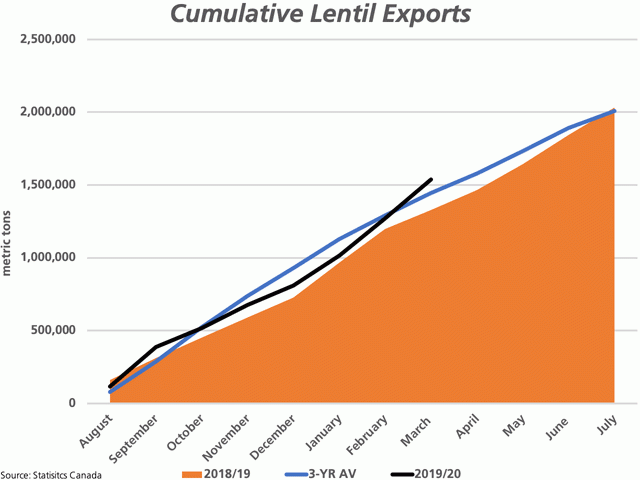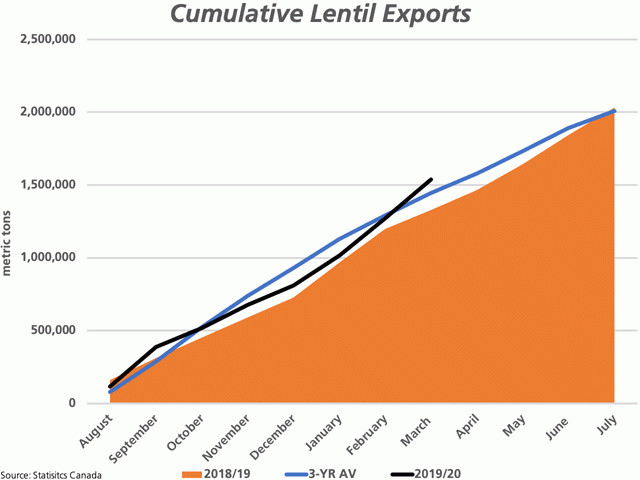Canada Markets
Statistics Canada March Trade Data
Statistics Canada's March merchandise trade report points to a sharp decline in both the country's imports and exports, with March exports down 4.7% to the lowest level since January 2018 and imports down 3.5% to the lowest level since October 2017. Both imports and exports were down close to 10% from March 2019, while at the same time, the largest month-over-month drop in the Canadian dollar since January 2015 was reported.
Canada's trade deficit with the world increased from $894 million in February to $1.4 billion in March.
Exports for the broad farm, finishing and intermediate food products were reported to rise by 12.1% in March to $3.5822 billion, largely due to a rebound in activity following the rail blockades experienced in February. This is the largest monthly dollar-value sales reported since January 2017.
Here's a look at miscellaneous ag commodity date commodity data found in Tuesday's reports.
Statistics Canada reported Canada's lentil exports at 267,462 metric tons in March up for a third straight month as seen on the attached chart, the largest monthly volume shipped in six months and the largest March volume shipped in data checked since 2009-10. The largest increase was seen to the United Arab Emirates, the top designation this month at 61,795 metric tons (mt), while Turkey followed with a volume of 47,819 mt shipped. The volume shipped to India declined to 29,893 mt, the smallest volume shipped in three months.
Cumulative lentil exports are shown at 1.536 million metric tons (mmt), up 15.8% from the same period in 2018-19 and just 1% below the five-year average. This represents 73.2% of the current AAFC crop-year forecast of 2.1 mmt, ahead of the steady pace needed to reach this level. Given current estimates of supplies, ending stocks could fall to the tightest levels in four years.
Dry pea exports were reported at 223,249 mt, down from the previous month but the highest March exports reported in three years. The top destination was China, with 58% of the volume shipped. Cumulative exports total 2.459 mmt, up 22.5% from the same period in 2018-19 and 10.5% higher than the five-year average. The current pace of movement is just slightly ahead of the steady pace needed to reach the current AAFC forecast of 3.6 mmt, which was revised 100,000 mt higher in the April supply and demand tables. Given current estimates of supplies of dry peas, 2019-20 ending stocks could fall to the tightest levels seen in four years, along with lentils.
P[L1] D[0x0] M[300x250] OOP[F] ADUNIT[] T[]
Chickpea exports totaled 13,682 mt in March, the highest monthly volume shipped in 12 months. Volumes grew this month into Pakistan and the United States, the top two destinations that were shipped close to 75% of the March volume. Cumulative exports continue to struggle, with the current 71,490 mt representing 76% of the 2018-19 volume and 87% of the five-year average. Cumulative movement is well behind the steady pace needed to reach the current forecast of 127,000 mt, which was revised 3,000 mt lower in the April AAFC report.
Export data shows 10,453 mt of canary seed exported during the month, close to unchanged from February, with Mexico and Spain the two largest destinations taking 41% of the total volume. Cumulative exports total 107,470 mt, up 7.2% from 2018-19 and 8.8% higher than the five-year average, while reaching 68% of the current 158,000 mt AAFC forecast, in-line with the steady pace needed to reach this forecast.
March mustard exports totaled 9,351 mt, the highest volume shipped in three months, with the volume being the smallest March volume shipped in six years. While the U.S. remains the largest buyer, the uncertainty surrounding the North American baseball season and the demand for yellow mustard could be a bearish factor for the balance of the crop year. Cumulative exports total 73,351 mt, which represents 90% of the same period in 2018-19 and 92.4% of the five-year average. This also represents 63.8% of the steady pace needed to reach the current 115,000 mt export target, which was revised 5,000 mt lower in April.
Flax exports in March totaled 16,661 mt, the lowest volume shipped in five months and the lowest March exports in nine years. The U.S. was the largest buyer this month, after swapping places with China over a number of months, while the 3,931 mt shipped to China was the smallest volume shipped in five months. Crop year to date, 172,059 mt has been shipped, which represents 63% of the 2018-19 volume and 45.6% of the five-year average. This represents 43% of the current 400,000 mt AAFC export forecast, while behind the steady pace needed to reach this volume.
Canada exported 171,987 mt of soybeans in March, up from the previous month, with Japan, Norway, Indonesia and the U.S. shipped close to equal volumes accounting for 61% of this volume. Cumulative exports of 2.585 mmt are only 66% of the 2018-19 volume for this period and 75.4% of the five-year average. This represents 60% of the current 4.3 mmt export forecast released by AAFC, while just slightly ahead of the steady pace needed to reach this forecast.
Exports of corn totaled 24,821 mt in March, 24,821 mt almost all to the U.S., while consistent with monthly volumes shipped this crop year. The cumulative exports of 169,995 mt are 21% of the volume shipped in the same period last crop year and 31% of the five-year average, while representing just 21% of the current 800,000 mt export target, which was revised 200,000 mt lower in April and will likely face further revisions prior to the end of the crop year.
Canola oil exports were reported at 335,986 mt in March, which appears to be a monthly record for movement in any month. A reported 62% of the crude oil was shipped to China, while 85% of the refined oil was shipped to the U.S. Year-to-date exports total 2.266 mmt, 9% higher than the same period last crop year and 11% higher than the three-year average.
Canola meal exports were reported at 457,676 mt in March, a volume that also appears to be a monthly record, with the majority move to the U.S. although China stepped up to take the largest volume shipped in six months. Meal exports total 3.338 mmt in the August through March period, 6% higher than the 2018-19 volume and 5.6% higher than the three-year average.
Ethanol imports in March totaled roughly 105 million liters of denatured ethyl alcohol. While this is down from the month of February, it is significantly higher than March imports over the past decade checked. January through March imports for 2020 are 33% higher than the same period in 2019. This bears watching.
Exports of Canadian oats were reported at 151,817 mt, while Aug-March exports total 1.3 mmt, 6.8% higher than the same period in 2018-19 and 8.1% higher than the five-year average. The cumulative volume accounts for 50% of the current 2.6 mmt forecast, behind the steady pace needed to reach this volume.
Canadian barley exports totaled 206,472 mt, up from the previous month. Cumulative exports total 1.466 mmt, which is 82% of the volume shipped in the same period in 2018-19 while 25% higher than the five-year average. This volume accounts for 60% of the 3 mmt export target forecast by AAFC, which was revised 150,000 mt lower in April, while is behind the steady pace needed to reach this forecast.
DTN 360 Poll
This week's poll asks what you think of the move to delay the release of ag reports by Statistics Canada as shown in their revised schedule due to COVID-19. You can weigh in with your thoughts on this poll, found at the lower-right of your Canadian site Home Page.
Cliff Jamieson can be reached at cliff.jamieson@dtn.com
Follow him on Twitter @Cliff Jamieson
© (c) Copyright 2020 DTN, LLC. All rights reserved.






Comments
To comment, please Log In or Join our Community .